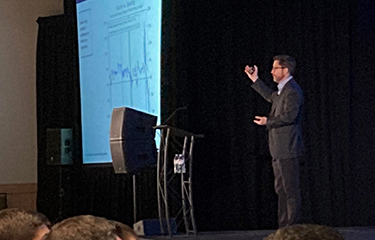Recession “penciled in this year,” Wells Fargo’s Tim Quinlan says

The United States may already be in recession, but if it isn’t, it is likely to arrive there soon, according to Wells Fargo Senior Economist Tim Quinlan.
Speaking at the 2023 National Fisheries Institute Global Seafood Market Conference in La Quinta, California, U.S.A., Quinlan said a huge drop-off in consumer sentiment, rapidly diminishing savings figures, stubbornly high inflation, and mounting national debt have combined with other factors to drag down the forecast for the U.S. economy this year.
“We do have a recession kind of penciled in this year. This is in response to the highest inflation in 40 years and the significant rate increases that the [U.S. Federal Reserve] has had to implement to deal with that,” he said. “We're kind of pivoting from a year in which inflation and defense efforts to contain it really drove financial market activity, and that will remain kind of a key theme this year. But as inflation goes from high and rising to high and falling, it will become more about how different parts of the economy manage that transition, and specifically, the staying power of the consumer. And there we are on a bit of shaky ground.”
U.S. retail sales have fallen in three out of the last four months and “suggests that some of this uncanny staying power of the consumer is beginning to pivot a little bit,” Quinlan said.
Wages are not keeping up with expenses in the U.S., resulting in a downswing in real disposable income. But consumers have not cut back on their spending in response, according to Quinlan.
“How much you made typically determined how much you're able to spend, but that has simply not been the case [recently],” he said.
Americans saved money in the early days of the Covid-19 pandemic, but then as their incomes improved with higher wages, they began spending. And now many Americans are spending down their pandemic-era savings, Quinlan said. But with higher interest rates pushing up the price of private equity lines of credit and credit card borrowing, Quinlan said a reckoning is coming.
“We don't see a path for this to sustainably continue to drive economic growth,” he said.
Wells Fargo is predicting inflation will persist but will trend lower, and in response the Fed will raise the federal interest rate from its current level of 4.5 percent to 5.25 percent and keep it there – a prediction Quinlan acknowledged was “a little bit outside of the consensus,” especially as many markets have already priced in an expected reduction in the federal interest rate.
Providing a further prognostication, Quinlan said the labor market would not ease, as is typical during a recession.
“I wouldn't hold my breath on that. We have the unemployment rate peaking at about 5.5 percent in this cycle, which if realized, would be the lowest peak for unemployment of any recession in the post-World War II era,” he said. “The labor market is apt to remain rather tight through this downturn. And what that means for you is … your employment costs are not coming down.”
Quinlan said Wells Fargo is watching the rising national debt with concern, especially as it portends a fight on Capitol Hill over the nation’s borrowing limit.
“You've got a new [Republican] Speaker of the House who says we're not going to raise the debt ceiling without an agreement from Democrats to cut spending and you got Democrats saying we're not going to negotiate over the debt ceiling, so something's got to give there,” he said. “In the meantime, the cost of capital remains historically high.”
Rabobank Senior Cross-Asset Strategist and Managing Director Christian Lawrence, speaking after Quinlan at GSMC, said predictions for the United States’ GDP in 2023 range from a contraction of 0.8 percent to growth of 1.3 percent. He said the fate of the U.S. economy is increasingly linked to the global economy, which is facing continued unprecedented volatility.
“Globalization is changing. Commodities are being weaponized. And we're moving to a more-fractured, multipolar world,” Lawrence said.
Even three years on from the beginning of the Covid-19 pandemic, the virus’ impacts continue to drag significantly on the global economy. And while Europe has avoided the worst fears of an energy crisis spurred by being cut off from Russian gas supplies in light of its response to Russia’s invasion of Ukraine, gas prices are still high and likely to remain so through 2023, according to Lawrence.
In recent months, the U.S. dollar has lost some of the gains it made against other international currencies, but it is likely to strengthen once again through 2023, Lawrence said. That strength insulates its economy from some of the volatility facing global markets, but does not offer umbrella protection for all sectors of the U.S. economy, Lawrence said. He said the bottom 20 percent of U.S. households by income “were probably already in a consumer-driven recession last year,” as most of the savings coming out of the pandemic was concentrated in the top half of U.S. households.
“Of course, a lot of that was about the distribution of equity ownership. But my point is the economy has been very different over the last year, depending on which income bracket you are in,” he said. “In fact, the bottom 20 percent of households have already seen their support from the government run out and their savings have already evaporated. The bottom 20 percent of households … are worse off than they were pre-Covid. And there's kind of this trickle up effect. Now we're starting to see more layoffs and higher paying jobs, we are likely to see that part of the economy starts to reduce consumption fall into this recession.”
Photo courtesy of Cliff White/SeafoodSource






Share